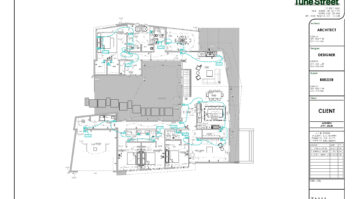I’m sure everyone reading this watches at least one police procedural drama in his or her life. Be it Law & Order, NCIS, Blue Bloods, Hawaii Five-0, or one of the dozens of others. And in every one of those, they always talk about chain of custody when it comes to evidence. When they go to court, they have to prove chain of custody was maintained so that there is no chance the evidence was tampered with or mishandled.
The same thing goes for your job sites. Instances will always come up where a cutout or a wire has to be moved just a few inches. Maybe it is because you put your speaker pre-construction brackets in first and then the electrician did all of the lights later, and now the in-wall speakers aren’t equidistant from the center light. The contractor offers to move the speaker bracket for you, which sounds great to you. Why roll a truck to cut a single hole in sheetrock and move the speaker wire. So all is good. Until you go to the trim-out to put in the speakers, and find out that the speaker cut-out moved into a different stud bay but the contractor didn’t pull the speaker wire over too. So now you have to open up the wall to get the speaker that has now fallen to the floor in the wrong stud bay, drill the hole through the stud and pull the wire through to the new location. The client is pissed (even though the patch is easy), and is blaming you because it is your speaker and your wire, and the contractor just shrugs his shoulders—he was doing you a favor after all.
You need to maintain chain of custody for your jobs. It doesn’t matter how small a change may seem, but you need to roll a truck. And if it is a change order as in the above example, you should charge for the truck roll to cover your costs. It will save immeasurable headaches later. Nine out of 10 times, the contractor will do it right and there will be no issues. But that 10th time? Look out!

Photo: ThinkStock
Also remind clients that if anything has to be moved in the future, that they need to call you. Are they painting the living room? Then you should go over to take down the TV and put it back up a few days later when the painters are done. If they don’t call you, or worse, you tell them to just have the painter do it, and the head on that 25-foot HDMI that is in a plaster wall gets damaged, there is going to be hell to pay. The same thing goes when they are moving. The mover’s specialty is packing and moving items, so let them do what they are great at. You should take down the TV, have them pack it and move it, and then you should rehang it in the new home. Too often I’ve seen instances where other trades or services try to do their best, and they just make things worse. Either they damage a wire or they misconnect things when they set it back up, and the client is calling you in a panic because he or she has people coming over and the TV isn’t working. So instead of you having the opportunity to schedule the job and make sure it is done right, you are now doing a rush service call, if you can get a body there in time. The client is stressed, you are stressed, and the client is paying for a service call he or she shouldn’t have needed.
Remember, it is your reputation on the line. Clients aren’t going to remember who moved the speaker or who broke the wire, just that something was broken with the system and the AV guy charged them extra for a rush, after-hours service call. Avoid the headaches and make the truck roll early, rather than when it is too late. And you never know, that extra truck roll could turn into a selling opportunity. If they are painting some rooms, now would be a great time to pull some speaker wire and put in that whole-home audio system they’ve been jonesing for, but never got around to.
+Todd Anthony Puma is president of The Source Home Theater Installation in New York City.








